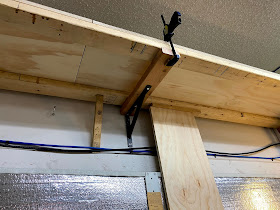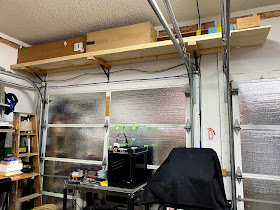Large parts storage
Thinking too far down the road can occasionally have negative consequences, and being emotionally ok with not doing so can prove to have some advantages.
Getting overwhelmed by future details will definitely put a chill on one’s aspirations, and I’m pretty sure I would have never started this project had I required all the answers ahead of time.
One needs to allow for the vagaries of life to do their thing, and not get too wrapped around possible future events.
One item I had not given a lot of thought in the past was large parts storage, and with the canard sitting unfinished on my table for the past three years, this subject became unavoidable.
 |
| Running out of space fast |
In case you wondered, I did pitch the typical “May I store it in the house?” cry for help to my wife, even though I was fully aware of the impossibility of maneuvering the 11 foot long canard through the small corridors of the house.
After the millisecond it took her to decide against it, I resigned myself to building some kind of storage solution in my already overcrowded shop, and I immediately identified a pretty large area of untapped potential above the garage door.
 |
| Promising new storage prospect |
Before even thinking about storing the canard though, I needed to finish the post-glassing cleanup that was so rudely interrupted when JT’s avionics wizardry got delivered in the summer of 2017.
 |
| Gotta get rid of the Bondo blobs, the red tape, the fiberglass over it, then sand the transition smooth. |
 |
| A razor knife and a sharp chisel work best |
 |
| Sanding the transition smooth |
Now, let’s get back to the storage…
Though I needed to store large parts, weight would not be substantial. This allowed me to design a shelf with only two heavy duty metal brackets solidly attached to the garage door posts with lag screws.
 |
| 1000 lbs heavy duty shelf bracket |
 |
| Shelf coming together |
I did recycle two 10 foot beams used in the building of the straight tower of Pisa to span the brackets, and because weight was not an issue (but maximizing available volume was), I laid them on their wider side, accepting that they might sag slightly if too much weight was to be applied.
 |
| Second crossmember attached |
Before going too far with this design though, I decided to stress test the structure to higher than intended rating.
 |
| Good enough for me, good enough for the canard. |
I then finished up the shelf by covering the span with pine plywood screwed to the crossmembers.
 |
| Adding a floor |
But the more I looked at the shelf, the more I wished I had added a center support. So, I went back to the store and picked up some more hardware to take care of this issue.
 |
| Jacking up the center section |
 |
| Third member reporting for duty! |
 |
| Installing the center support |
With the canard cleaned up and the shelf completed, I reused the foam the canard was cut out of, as a base for long term storage.
 |
| Taking no chances with this baby |
 |
| Storing the canard leading edge down will prevent any warping |
 |
| That's one out of the way storage. Love it! |
Next thing you know, other items cluttering the shop ended up filling the unused portion of the new shelf.
 |
| New storage is getting popular already |
Crap! It already looks like I might need to build more shelving in the future.
Good thing I never plan that far ahead.





































